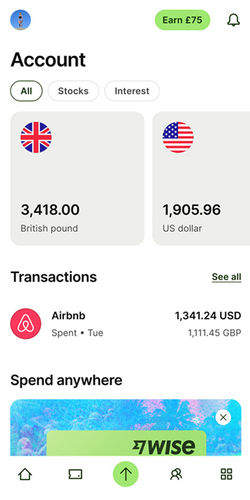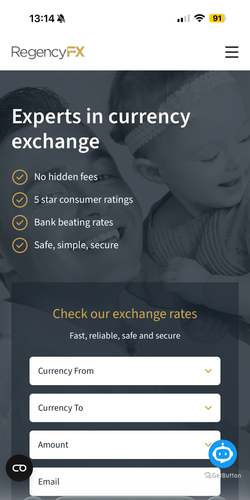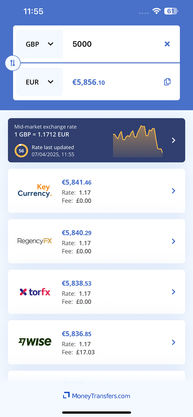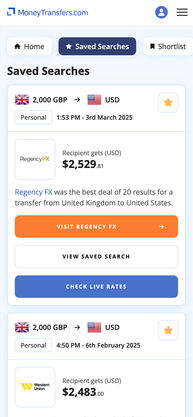Find the best ways to transfer money to China
Compare money transfer deals for sending CNY.
Find the best, cheapest, and easiest ways to send money to China at the best CNY exchange rates.
Read on for the best deals, expert information, and all you need to transfer money to China.
Send money to China
"Over 16 million customers use Wise, mostly for their excellent mobile app, transparent fee structure & use of mid-market rates. Now increasingly used for larger transfers."
"Over 16 million customers use Wise, mostly for their excellent mobile app, transparent fee structure & use of mid-market rates. Now increasingly used for larger transfers."
"Over 16 million customers use Wise, mostly for their excellent mobile app, transparent fee structure & use of mid-market rates. Now increasingly used for larger transfers."
"Xe has over 30 years of currency exchange experience, and is one of the most reputable names on the market. 200 countries, 100 currencies, & funds often received in seconds."
"Xe has over 30 years of currency exchange experience, and is one of the most reputable names on the market. 200 countries, 100 currencies, & funds often received in seconds."
"Xe has over 30 years of currency exchange experience, and is one of the most reputable names on the market. 200 countries, 100 currencies, & funds often received in seconds."
"Over 16 million customers use Wise, mostly for their excellent mobile app, transparent fee structure & use of mid-market rates. Now increasingly used for larger transfers."
"Over 16 million customers use Wise, mostly for their excellent mobile app, transparent fee structure & use of mid-market rates. Now increasingly used for larger transfers."
"Over 16 million customers use Wise, mostly for their excellent mobile app, transparent fee structure & use of mid-market rates. Now increasingly used for larger transfers."
"Revolut has 50+ million customers globally. You can hold up to 36 currencies in the app and send money quickly in 70+ currencies to 160+ countries."
"Revolut has 50+ million customers globally. You can hold up to 36 currencies in the app and send money quickly in 70+ currencies to 160+ countries."
"Revolut has 50+ million customers globally. You can hold up to 36 currencies in the app and send money quickly in 70+ currencies to 160+ countries."
"Xe has over 30 years of currency exchange experience, and is one of the most reputable names on the market. 200 countries, 100 currencies, & funds often received in seconds."
"Xe has over 30 years of currency exchange experience, and is one of the most reputable names on the market. 200 countries, 100 currencies, & funds often received in seconds."
"Xe has over 30 years of currency exchange experience, and is one of the most reputable names on the market. 200 countries, 100 currencies, & funds often received in seconds."
"OFX have been helping individuals and businesses send money for over 25 years. Transfer in 50+ currencies to 170+ countries, with 24/7 phone access to currency experts."
"OFX have been helping individuals and businesses send money for over 25 years. Transfer in 50+ currencies to 170+ countries, with 24/7 phone access to currency experts."
"OFX have been helping individuals and businesses send money for over 25 years. Transfer in 50+ currencies to 170+ countries, with 24/7 phone access to currency experts."
"Regency's UK-based account management team has vast experience. Get support on all kinds of transfers, from overseas property transactions to business payments & more."
"Regency's UK-based account management team has vast experience. Get support on all kinds of transfers, from overseas property transactions to business payments & more."
"Regency's UK-based account management team has vast experience. Get support on all kinds of transfers, from overseas property transactions to business payments & more."
"Remitly focuses on sending money to friends and family in Asia, Africa and South America. Wide coverage and well-suited to regular transfers home."
"Remitly focuses on sending money to friends and family in Asia, Africa and South America. Wide coverage and well-suited to regular transfers home."
"Remitly focuses on sending money to friends and family in Asia, Africa and South America. Wide coverage and well-suited to regular transfers home."
"Xoom, a PayPal service, allows you to send money in more than 160 countries. You can send cash for over-the-counter pickup or home delivery, as well as send by bank transfer or debit card."
"Xoom, a PayPal service, allows you to send money in more than 160 countries. You can send cash for over-the-counter pickup or home delivery, as well as send by bank transfer or debit card."
"Xoom, a PayPal service, allows you to send money in more than 160 countries. You can send cash for over-the-counter pickup or home delivery, as well as send by bank transfer or debit card."
"Send money to over 40 destinations online and in the mobile app."
"Send money to over 40 destinations online and in the mobile app."
"Send money to over 40 destinations online and in the mobile app."
"Paysend has transparent fees and rates, with transfer sent within seconds to your recipient's bank. They also have global 24/7 support for any enquiries, and bank-level security."
"Paysend has transparent fees and rates, with transfer sent within seconds to your recipient's bank. They also have global 24/7 support for any enquiries, and bank-level security."
"Paysend has transparent fees and rates, with transfer sent within seconds to your recipient's bank. They also have global 24/7 support for any enquiries, and bank-level security."
"Moneycorp is an established player in the market, with a focus on private clients and corporates. Make overseas payments in over 120 currencies and 190 countries."
"Moneycorp is an established player in the market, with a focus on private clients and corporates. Make overseas payments in over 120 currencies and 190 countries."
"Moneycorp is an established player in the market, with a focus on private clients and corporates. Make overseas payments in over 120 currencies and 190 countries."
"Moneygram is a well established service with over 80 years in the sector. They support over 200 countries worldwide and have over 440,000 retail locations."
"Moneygram is a well established service with over 80 years in the sector. They support over 200 countries worldwide and have over 440,000 retail locations."
"Moneygram is a well established service with over 80 years in the sector. They support over 200 countries worldwide and have over 440,000 retail locations."
How to send money to China with the best rate
Always compare rates
Don't pay more than you have to. Use our live comparison tool to make sure you aren't missing the best rates when sending money to China.
Choose a provider
Select the provider that offers you the most CNY and fits your needs.
Click, sign up & send
Follow the steps & make your transfer. Your funds will soon be on their way to your chosen country & currency.
The best way to send money to China: Wise
After reviewing and testing 11 money transfer providers supporting CNY transfers, we found Wise to be the top choice for money transfers to China as of January 2026.
With quick transfers, a low markup of 0.04% on CNY exchange rates, and a low fee of $68.39, Wise offers the ideal balance of cost, speed, and features for CNY transfers.

Cheapest way to send money to China: Remitly
If you want to make the most of your CNY transfer, the cheapest way is to use Remitly and pay for your transfer with a bank transfer.
With just $0 in fees and 0.05% markup, Remitly is 0.22% cheaper than the next best option.
With Wise, if you were to send 7,000 USD to CNY, your recipient would get 48,951.7 Yuan Renminbi, this is more than with other providers on our list.
*Based on 7,000 USD transfer.

Regency FX: The fastest way to send money to China
With Regency FX, the transfer time to China is minutes - 24 hours.
They charge $0 in fees and apply a 0.27% markup on the CNY exchange rate, which is 0% better than the second-best option.
For the best combination of cost and speed, we suggest using bank transfer to fund your CNY transfer.

Easiest way to send money to China: Wise
We recommend Wise if you are after convenience. Their app is made for CNY transfers on the go, their fees are low, and transfer times are fast.
They may not always be the cheapest or the fastest for transfers to China, but the difference would be minimal, especially on smaller CNY transfers.
By “easiest”, we mean the service that is easy to get started with, is fully transparent, and offers a good balance of cheap and fast transfers.

Understanding money transfers to China
Always compare your transfer options to China, don't settle for the most popular choice.
Almost all services supporting CN will include the fees and the markup on the ‘real’ CNY rate.
It will heavily depend on your deposit method, delivery options, the amount of CNY you send, and your location.
Our comparison includes 11 providers offering money transfer services to China.
Making large money transfers to China
When sending large amounts of Yuan Renminbi to China, it's important to consider factors like the limits, CNY rates, customer support, as well as legal and government-imposed restrictions in China.
Wise is our top recommendation for moving large amounts of CNY.
Whether you're purchasing property in China, need to pay tuition fees, have a wedding there, or transfer money for business in China, Wise will ensure a smooth and secure transaction.
Of all the companies we’ve tested and reviewed that specialize in large CNY transfers, Wise consistently ranked as the top-rated choice.
They charge $68.39 per transfer and apply 0.04% markup on top of the CNY exchange rate, making them perfect for moving big amounts.

Understand the costs of money transfers to China
The total cost of CNY transfers depends on your location, the amount of CNY sent, the delivery/deposit methods, transfer fees, and the markup applied to the CNY exchange rate.
Transfer fee
The money transfer service you use to send Yuan Renminbi can apply a fixed fee, a percentage-based fee, or a combination of both.
For example, a $7,000 transfer to China will cost you $0 in fees with Remitly, based on our January 2026 analysis of 11 services supporting Yuan Renminbi transfers.
CNY exchange rate markup
An exchange rate markup is the percentage added to the mid-market CNY rate.
Using the same example, Wise offers the best CNY exchange rates, with a 0.04% markup on the USD-CNY rate. This means for every USD sent, you receive 6.9964 CNY with 0.04% deducted from it.
Deposit method
How you fund your transfer can significantly impact the overall cost.
Bank transfer is the most common option, costing up to $490 per transfer to China.
Debit card transfers can go as high as $0 in fees, while credit cards are usually more expensive and may include additional cash advance fees.
bank transfer is the cheapest payment method for sending CNY.

How to get the best CNY exchange rate for transfers to China
An exchange rate represents the value of the Yuan Renminbi (CNY) relative to another currency. Since it fluctuates continuously, the rate you get directly affects the amount of CNY you receive.
Recent trends in CNY exchange rates:
The average rate was 7.0161 Yuan Renminbi per US Dollar, with a high of 7.0285 CNY/USD and a low of 6.9964 CNY/USD.
During the past week, the CNY/USD exchange rate experienced some fluctuations. Ensuring you exchange or convert money at a higher rate would result in more CNY received.
Wise is our top recommendation for sending CNY as it offers an exchange rate that is 0.04% above the mid-market rate, which is 0% cheaper than the next best option.
Secure the best CNY exchange rates with our rate alerts
Sign up for our rate alerts, and we'll notify you when it’s the best time to send CNY!
Payment methods available for money transfers to China
How you fund your money transfer to China directly affects the speed, cost, and the amount of CNY your recipient will receive. Here are the most common options for funding your transfer to China:
Bank transfers
Bank deposits are reliable and common for international CNY transfers, available through most services.
While they tend to be cheaper, it may take up to 2-3 business days for the funds to arrive.
You also may have an option to use the SWIFT network for a bank deposit to China, avoid it where possible. SWIFT deposits are slow and expensive, instead check if there are cheaper options.
Based on our recent testing of 11 providers accepting China transfers, we found Remitly to be the cheapest option, charging $0 per transfer with a 0.05% markup.

Debit and prepaid cards
Debit card transfers to China are generally faster than bank transfers. Most CNY transactions will be completed within a few hours. However, this convenience usually comes with increased fees.
We recommend Remitly for debit and prepaid card deposits when sending money to China. Remitly charges a 0.05% markup on the CNY rate and $0 in transfer fees.

Credit cards
A credit card deposit is another option for sending CNY to China.
Typically it is more expensive, and your CC company may charge you cash advance fees, and apply increased interest rates.
If you want to fund your transfer to China with a credit card, we to get the best deal.

How we analyze the market
We track the cost, speed, and product offerings of the leading money transfer services available in China.
Our comparison engine and algorithms evaluate providers based on over 25 factors, including transfer fees, ease of use, exchange rates, mobile apps, transfer times & customer support.
We also consider how these services are rated on platforms like TrustPilot, AppStore, and Google Play, giving you a comprehensive view of what to expect.
This thorough analysis helps you get the best available deal - every time you want to move money to China.
We also provide unbiased and detailed reviews of all the top money transfer companies. You can use these reviews to find the best service for your needs when sending money to China
For a deeper understanding of our commitment to integrity and transparency, we invite you to read our editorial policy and review methodology.

Related transfer routes
Send money from China
FAQs
Find answers to the most common questions on our dedicated FAQ page.
Are there any limits when sending CNY?
Are there any tax implications on CNY transfers?
What are the fees and exchange rates?
How long does it take to transfer money to China?
Can I schedule regular payments to China?
What currency is used in China?
Can I send CNY from any country?
What should I do if something goes wrong with my transfer to China?
Can I just wire money to China with my bank?
Can I use MoneyTransfers.com to transfer money?
Tools & resources
Contributors





.svg)








.svg)




